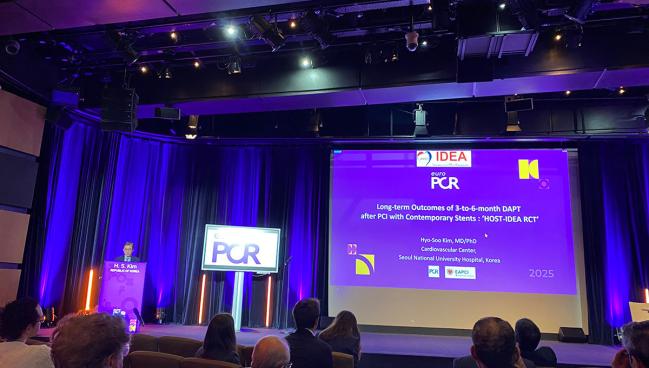Short DAPT All That’s Needed With Contemporary DES: HOST-IDEA at 3 Years
The results suggest potential harm when leaving patients who’ve received ultrathin-strut stents on DAPT beyond 1 year.

PARIS, France—Three-year findings from the HOST-IDEA trial continue to support a strategy of shorter-duration dual antiplatelet therapy (DAPT) following PCI with contemporary, ultrathin-strut drug-eluting stents.
The results also suggest “that expanding DAPT beyond 1 year significantly increases the risk of major bleeding without offering ischemic benefit,” reported Hyo-Soo Kim, MD, PhD (Seoul National University Hospital, Republic of Korea), at EuroPCR 2025.
Kim said he will no longer consider putting a patient on DAPT for longer than 12 months after PCI, and that he recommends to his colleagues: “Forget about DAPT beyond 1 year.” When his team started this study, which excludes patients with STEMI, some thought prolonged DAPT might be needed in patients who received multiple stents, “but during that period, there have been many clinical trials that support strongly that short DAPT may be enough, not only in high-bleeding-risk but also in ordinary low-bleeding-risk populations.”
HOST-IDEA, as previously reported by TCTMD, showed that 3 months of DAPT was noninferior to at least 12 months of DAPT with regard to net adverse clinical events (NACE) at 1 year among more than 2,000 patients undergoing PCI with the Orsiro (Biotronik) and Coroflex ISAR (B. Braun) stents, two devices that feature ultrathin struts and advanced polymer technology.
The new analysis, with follow-up out to 3 years, showed similar risks of the primary NACE outcome (7.7% vs 8.2%; HR 0.94; 0.69-1.29), target lesion failure (4.9% vs 5.4%; HR 0.92; 95% CI 0.62-1.36), and major bleeding (3.3% vs 3.5%; HR 0.96; 95% CI 0.59-1.56) between the short- and long-term DAPT cohorts. Landmark analyses from year 1 onwards for each of these endpoints confirmed the main results. The median DAPT durations for patients assigned to short- and long-term therapy were 99 and 403 days, respectively.
In a secondary landmark analysis of 1,842 patients without clinical events through 1 year after randomization, those who stayed on DAPT for more than 1 year (n = 583; median duration 1,025 days) had increased risks of the primary outcome (adjusted HR 1.92; 95% CI 1.09-3.36), major bleeding (adjusted HR 2.62; 95% CI 1.16-5.92), and any revascularization (adjusted HR 2.25; 95% CI 1.27-3.99) compared with patients who stayed on DAPT for less than 1 year (n = 1,259).
The “only benefit” of prolonged DAPT was a lower risk of stroke (adjusted HR 0.51; 95% CI 0.13-1.97), Kim reported.
Interestingly, he said, a history of previous revascularization and multivessel PCI were the two baseline factors that led physicians to more often prescribe more than 1 year of DAPT.
No Reason to Go Beyond 1 Year
Discussing the findings during the session, Marco Valgimigli, MD, PhD (Cardiocentro Ticino Institute, Lugano, Switzerland), said he hasn’t seen a reason to prolong DAPT beyond 1 year and now is “even less” supportive of the extended strategy in an unselected PCI population.
While the main intention-to-treat analysis “did not provide any clear disadvantage nor advantage of extending DAPT, that would be a very superficial interpretation of the data,” Valgimigli said, adding that a per-protocol analysis would show an excess of bleeding events in patients who remained on long-term DAPT and “no advantage of doing so.”
He highlighted the fact that the results don’t apply to patients at high risk of bleeding, as these individuals were not investigated here.
Yael L. Maxwell is Senior Medical Journalist for TCTMD and Section Editor of TCTMD's Fellows Forum. She served as the inaugural…
Read Full BioSources
Kim H-S. Long-term outcomes of 3-to-6-month DAPT after PCI with contemporary stents: ‘HOST-IDEA RCT’. Presented at: EuroPCR 2025. May 22, 2025. Paris, France.
Disclosures
- Kim reports receiving grants or speaker fees from Daiichi Sankyo, Boston Scientific, Terumo, Biotronik, Dio, Medtronic, Abbott Vascular, Edwards Lifesciences, Amgen, and Boehringer Ingelheim.





Comments